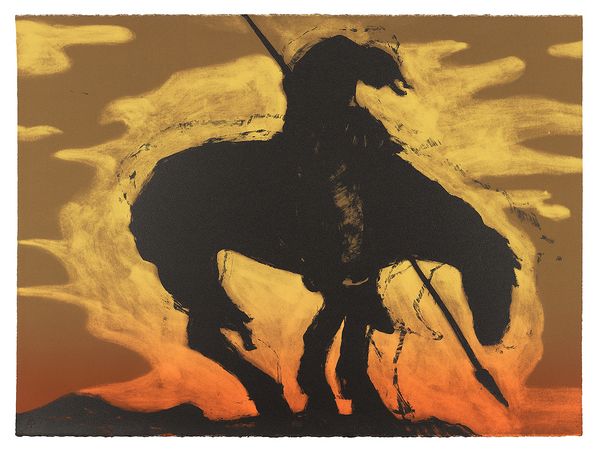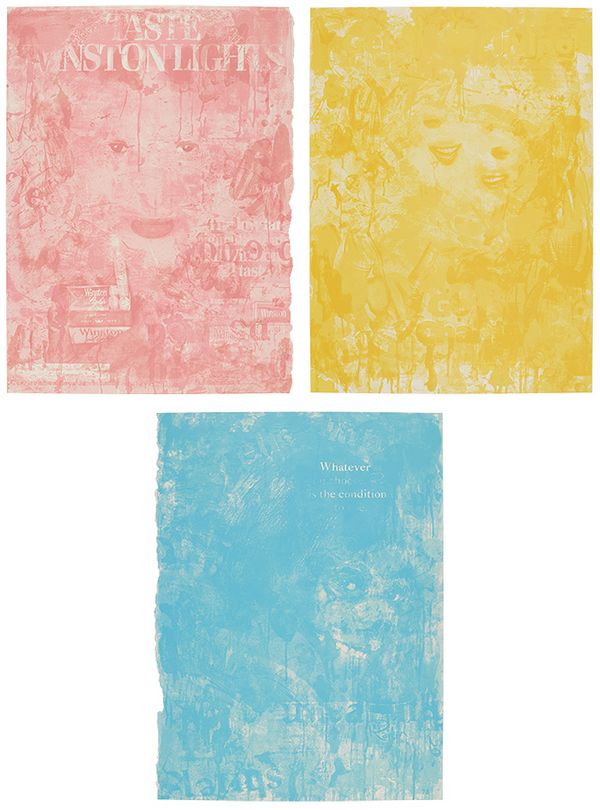Fritz Scholder (Luiseño), Indian Cliché (State III), 1978. Editions & Works on Paper New York.
Tamarind Lithography Workshop was founded in 1960 in Los Angeles as an experimental program to restore the dying art of lithography. While initiated by artist June Wayne with the support of the Ford Foundation, today Tamarind Institute operates as a nonprofit educational center and a division of the College of Fine Arts at The University of New Mexico.
Within a freestanding building on Albuquerque's original Route 66, Tamarind pioneers a state-of-the-art workshop, gallery, research library, and a program of artist residencies and advanced classes in the theory and chemistry of lithography. Tamarind also encompasses an extensive archive of historic material and 8000 lithographs produced by the workshop, along with a staff of highly trained printers, curators, and print experts. Through these facilities and personnel, the institute stimulates research, preservation of knowledge, and community among a diverse international following. This unique program is widely credited with revitalizing the creative medium of lithography and continues to provide the only printer training program of its kind in the world.
Tamarind sustains its operation and practices a high caliber of printing through its work as a printer and publisher of fine lithographs. Artists are invited for residencies ranging from 2-4 weeks, during which they explore the possibilities of lithography, collaborate with a team of printers, and engage with the New Mexico arts community. Tamarind is known for introducing artists to the process of collaborative printmaking, favoring projects with artists who are new to the medium and may work in disciplines outside of traditional printmaking.
Here, we highlight works from Tamarind’s collection in our upcoming New York Editions & Works on Paper auction, offering collectors the opportunity to own a piece of this legacy while supporting the institute’s mission.
Fritz Scholder (Luiseño)
Fritz Scholder (Luiseño), Indian with Beaded Sash, from Suite Fifteen, 1975. Editions & Works on Paper New York.
“One color by itself is pretty blah. I don’t care what color you take. It’s when you put the second color next to the first color that, then things start to happen, and you get vibrations, you get, when you get purple next to an orange, things are going to happen.”
—Fritz Scholder (Luiseño)
Noel Anderson
Noel Anderson, Ebony Files, the Albuquerque Suite, 2019. Editions & Works on Paper New York.
“The use of cotton and its attendant vocabulary once woven is an intricate exchange with American history. The grain of images, the ‘nap of the weave,’ the wavering borders suggest the margin creeps into the frame. Collapse is irresistible. Loose threads and the natural warp of the material represent a glitch that invites viewers to revisit their memories and notions.”
—Noel Anderson
Michelle Stuart
Michelle Stuart, Kuseping, from Tsikomo, 1974. Editions & Works on Paper New York.
“If I use up a certain medium with my questions, I start asking them in another medium. Each piece is a challenge to be true to yourself. Is this really who I am and what I want to say? How far can I go with this? It has to be lucid, although not too lucid! [...] You have to have things in [the piece] that might not be true in order to communicate the truth.”
—Michelle Stuart
Willie Birch
Willie Birch, Big Man, 2000. Editions & Works on Paper New York.
“This body of work comes out of a need to create works that are narrative, accessible, and emotionally connected in a direct way to the people they portray. As an artist who is committed to cultural history, I think these works act as visual commentaries that reconstruct our perception of race and class in America.”
—Willie Birch
Discover more from the Tamarind Institute >




